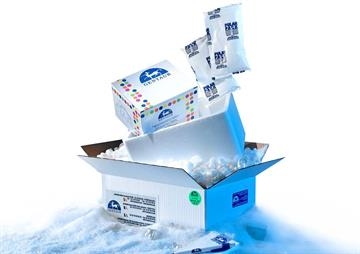APC Anti-Mouse IL-10 Antibody

APC Anti-Mouse IL-10 Antibody
181 €
In Stock
quantity
product details
Catalog number: 866 - RD22156F-100ug
Product Category: Business & Industrial > Science & Laboratory
Reddot BiotechGentaur
Size: 100μg
Related Products
103-M202
Anti-Mouse IL-10 Antibody
Interleukin 10 (IL-10), initially designated cytokine synthesis inhibitory factor (CSIF), was originally identified as a product of mouse T helper (Th) 2 clones that inhibited cytokine production by Th1 clones . The human ortholog of mouse IL-10 was subsequently cloned by cross-hybridization. Human and mouse IL-10 are 81% identical at the nucleotide and amino acid level. IL-10 is the prototypic member of the IL-10 cytokine family, including IL-10, IL-19, IL-20, IL-22 (IL-TIF), IL-24 and IL-26. A number of viruses, including Epstein-Barr virus (EBV) and human cytomegalovirus (HCMV), also encode viral members of the IL-10 family. Human IL-10 has cross-species actvity and is active on mouse cells. Mouse IL-10 is species-specific and does not act on human cells.
520.12 €
103-M404
Anti-Mouse IL-10 Antibody
Interleukin 10 (IL-10), initially designated cytokine synthesis inhibitory factor (CSIF), was originally identified as a product of mouse T helper (Th) 2 clones that inhibited cytokine production by Th1 clones . The human ortholog of mouse IL-10 was subsequently cloned by cross-hybridization. Human and mouse IL-10 are 81% identical at the nucleotide and amino acid level. IL-10 is the prototypic member of the IL-10 cytokine family, including IL-10, IL-19, IL-20, IL-22 (IL-TIF), IL-24 and IL-26. A number of viruses, including Epstein-Barr virus (EBV) and human cytomegalovirus (HCMV), also encode viral members of the IL-10 family. Human IL-10 has cross-species actvity and is active on mouse cells. Mouse IL-10 is species-specific and does not act on human cells.
748.5 €
103-P18
Anti-Mouse IL-10 Antibody
Interleukin 10 (IL-10), initially designated cytokine synthesis inhibitory factor (CSIF), was originally identified as a product of mouse T helper (Th) 2 clones that inhibited cytokine production by Th1 clones . The human ortholog of mouse IL-10 was subsequently cloned by cross-hybridization. Human and mouse IL-10 are 81% identical at the nucleotide and amino acid level. IL-10 is the prototypic member of the IL-10 cytokine family, including IL-10, IL-19, IL-20, IL-22 (IL-TIF), IL-24 and IL-26. A number of viruses, including Epstein-Barr virus (EBV) and human cytomegalovirus (HCMV), also encode viral members of the IL-10 family. Human IL-10 has cross-species actvity and is active on mouse cells. Mouse IL-10 is species-specific and does not act on human cells.
518.55 €
RD22156F-100ug
APC Anti-Mouse IL-10 Antibody
L-10 was originally described as Cytokine Synthesis Inhibitory Factor (CSIF) by virtue of its ability to inhibit cytokine production by Th1 clones. IL-10 shares over 80% sequence homology with the Epstein-Barr virus protein BCRFI. IL-10 inhibits IFN-γ, TNF-β, and IL-2 production by Th1 clones; inhibits macrophage-mediated IL-1, IL-6, and TNF-α synthesis; suppresses the delayed type hypersensitivity response; stimulates Th2 cell response (which results in elevated antibody production); and promotes mast cell proliferation in combination with IL-4.
181 €
RD22156F-25ug
APC Anti-Mouse IL-10 Antibody
L-10 was originally described as Cytokine Synthesis Inhibitory Factor (CSIF) by virtue of its ability to inhibit cytokine production by Th1 clones. IL-10 shares over 80% sequence homology with the Epstein-Barr virus protein BCRFI. IL-10 inhibits IFN-γ, TNF-β, and IL-2 production by Th1 clones; inhibits macrophage-mediated IL-1, IL-6, and TNF-α synthesis; suppresses the delayed type hypersensitivity response; stimulates Th2 cell response (which results in elevated antibody production); and promotes mast cell proliferation in combination with IL-4.









